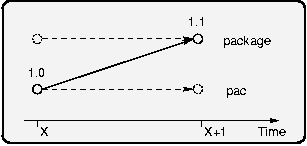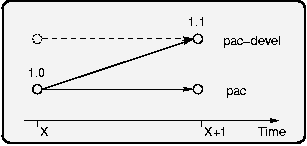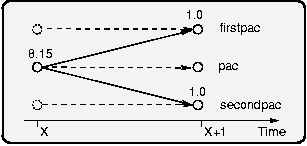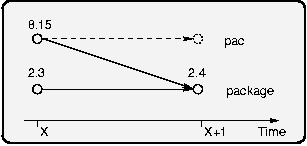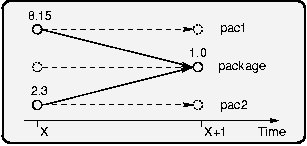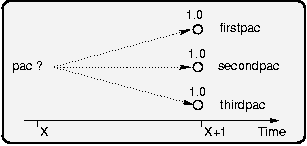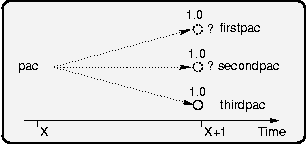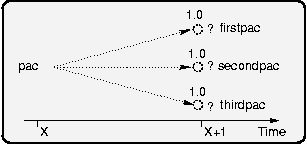Package Dependencies
İçindekiler
Expressing dependencies
Package dependencies are fully expressed in the .spec file used to build a package. There are no other means to specify dependencies.
Means to express dependencies
Each package can express dependencies to other packages by defining symbolic
names for Provides, Requires, and Conflicts.
These symbolic names are usually names of packages but can also be 'abstract'
names not related to a package.
These symbolic names can be used to express capabilities which are unrelated to a specific package. For example, the capability MTA (mail transport agent) is provided by multiple packages. sendmail and postfix being the most prominent.
It is important to remember that all symbolic names (being package or abstract names) reside in the same namespace. When choosing an abstract name (e.g. for a capability) it must not conflict with another package name.
To express update dependencies in order to replace one (old) package with another (newer) package, the Obsoletes tag is used.
Facts for RPM dependencies
- Each package implicitly provides its name.
There is no need to provide the package name, but other packages can require (or conflict with) the package name. - A package can not conflict with a symbolic tag it provides.
Since the package name is provided implicitly, a package can not conflict with itself. - Obsolete works on real package names only.
One can not obsolete a symbolic tag. - Symbolic names, as used in Requires, Provides, and Conflicts, are case-sensitive.
Basic dependencies
Installing a new package
| pac.spec | |
|---|---|
| Name: | pac |
| Version: | 1.0 |
| Requires: | |
| Provides: | |
| Obsoletes: | |
| Conflicts: | |
Updating a package
| pac.spec | |
|---|---|
| Name: | pac |
| Version: | 1.1 |
| Requires: | |
| Provides: | |
| Obsoletes: | |
| Conflicts: | |
The matching name and the higher version make this an update for pac-1.0
Renaming a package
| pac.spec | |
|---|---|
| Name: | pac |
| Version: | 1.1 |
| Requires: | |
| Provides: | |
| Obsoletes: | |
| Conflicts: | |
Strictly speaking, giving the old package name in the Provides: field is only needed if another package requires the old package name. However, the Provides: entry triggers the selection of the new package during update. It is this field which tells, I'm taking over for the old package. The Obsoletes: just ensures an atomic replacement so that no dependencies are broken. The Version: field is irrelevant here.
Splitting and Merging
Splitting off a sub-package
| pac.spec | |
|---|---|
| Name: | pac |
| Version: | 1.1 |
| Requires: | |
| Provides: | |
| Obsoletes: | |
| Conflicts: | |
Splitting a package into two
| pac.spec | pac-devel.spec | |||
|---|---|---|---|---|
| Name: | pac | Name: | pac-devel | |
| Version: | 1.1 | Version: | 1.1 | |
| Requires: | Requires: | |||
| Provides: | Provides: | pac:/file/from/pac | ||
| Obsoletes: | Obsoletes: | |||
| Conflicts: | Conflicts: | |||
The example shown lists separate .spec files for pac and pac-devel. (Remember that RPM allows to define sub-packages from a 'master' package with a single .spec file.
The dependency resolution (installing both new packages) is done by YaST with the split-alias mentioned in Provides: of pac-devel.
It is up to the package maintainer to decide about dependencies between pac and pac-devel. For example, if one wants to split a library package into a main, a -devel, and a -doc package. The main and the -doc package are independant, but the -devel package requires the main package.
During an update, the aformentioned split-alias tag is important. YaST only updates already installed packages, in this case only the main package. Without the split-alias, this would remove files needed for development which were part of the old main package but are not in the new main package.
The given Provides: for pac now triggers this update dependency as it tells YaST also to install pac-devel even though it was not installed before.
!! split-alias tags are used by YaST only, RPM never sees them. !!
If a package is splitted in more than two packages, the split-alias tags must be mutually exclusive. It's the only way for YaST to correctly handle such update dependencies.
Merging a package
| package.spec | |
|---|---|
| Name: | package |
| Version: | 1.1 |
| Requires: | |
| Provides: | pac |
| Obsoletes: | pac |
| Conflicts: | |
This is comparable to package rename. The new package must also incorporate the Provides and Obsoletes tags from the old package. This is needed to properly update from distribution before X.
Merging two packages into a new one
| package.spec | |
|---|---|
| Name: | package |
| Version: | 1.1 |
| Requires: | |
| Provides: | pac1 pac2 |
| Obsoletes: | pac1 pac2 |
| Conflicts: | |
Handling alternatives
Non conflicting
| firstpac.spec | secondpac.spec | thirdpac.spec | |||||
|---|---|---|---|---|---|---|---|
| Name: | firstpac | Name: | secondpac | Name: | thirdpac | ||
| Version: | 1.0 | Version: | 1.0 | Version: | 1.0 | ||
| Requires: | Requires: | Requires: | |||||
| Provides: | Pac | Provides: | Pac | Provides: | Pac | ||
| Obsoletes: | Obsoletes: | Obsoletes: | |||||
| Conflicts: | Conflicts: | Conflicts: | |||||
All three package provide the capability Pac and can be installed in parallel.
(The upper case letter in Pac is choosen on purpose to distinguish this tag from a package. Such capabilities must be agreed upon within the OpenSUSE community. Ask on opensuse-packaging before inventing your own tag !).
Example: xdm and kdm provide capability 'Display-Manager'
Partially conflicting
| firstpac.spec | secondpac.spec | thirdpac.spec | |||||
|---|---|---|---|---|---|---|---|
| Name: | firstpac | Name: | secondpac | Name: | thirdpac | ||
| Version: | 1.0 | Version: | 1.0 | Version: | 1.0 | ||
| Requires: | Requires: | Requires: | |||||
| Provides: | Pac | Provides: | Pac | Provides: | Pac | ||
| Obsoletes: | Obsoletes: | Obsoletes: | |||||
| Conflicts: | secondpac | Conflicts: | firstpac | Conflicts: | |||
The Conflicts express that only either firstpac or secondpac might be installed. But not both.
Mutually exclusive
| firstpac.spec | secondpac.spec | thirdpac.spec | |||||
|---|---|---|---|---|---|---|---|
| Name: | firstpac | Name: | secondpac | Name: | thirdpac | ||
| Version: | 1.0 | Version: | 1.0 | Version: | 1.0 | ||
| Requires: | Requires: | Requires: | |||||
| Provides: | Pac | Provides: | Pac | Provides: | Pac | ||
| Obsoletes: | Obsoletes: | Obsoletes: | |||||
| Conflicts: | secondpac thirdpac | Conflicts: | firstpac thirdpac | Conflicts: | firstpac secondpac | ||
Only one of firstpac, secondpac, or thirdpac might be installed.


